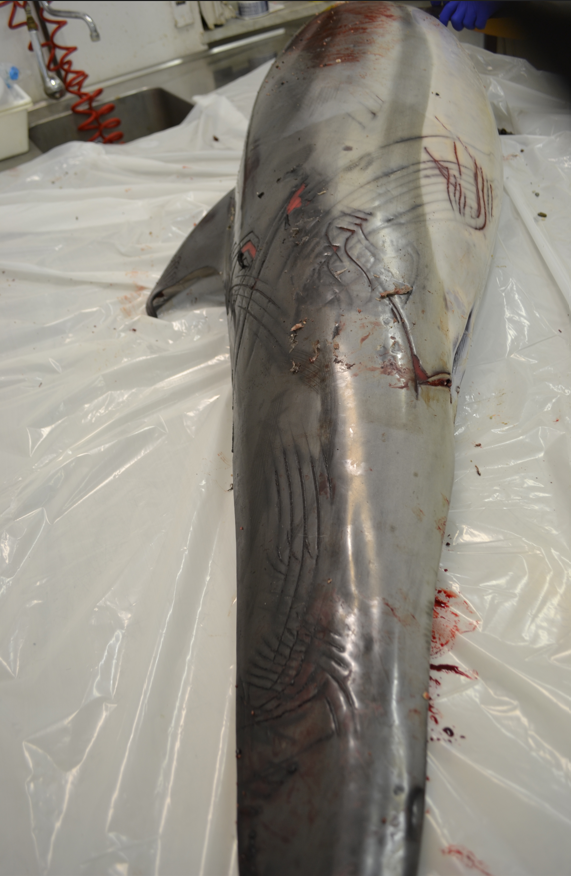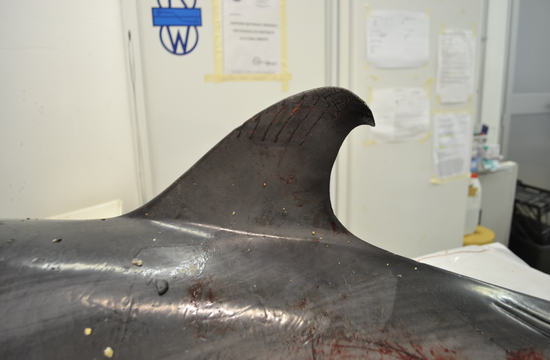Deadly Dolphin Encounters
In November 2020, beachgoers in the city of Spotorno on the Ligurian Sea made a grisly discovery—a stranded, dead striped dolphin (Fig. 1). The carcass was brought to CREDIMA (the national centre of necropsy and postmortem analysis of stranded cetaceans) in Imperia. My team and I—marine biologists and cetologists from the NGO Delfini del Ponente—assisted the vets in performing a necropsy. It is important to have both biologists and vets present at the post-mortems, so that all the biological and pathological aspects can be analysed.
Along the coast of Ligurian Sea, we see 10–15 strandings per year, mostly of striped and bottlenose dolphins. However, it was immediately clear that this case was not like the others and that this adult female had not died from natural causes. The body, still fresh and in good condition, displayed several marks and deep parallel wounds, caused by teeth, mostly on the back of the body (Fig. 2). The distance between the tooth marks corresponded to the interdental space of bottlenose dolphins.


Figure 2. Post-mortem of a striped dolphin revealed multiple injuries. External injuries (pictured) consisted of a series of parallel lacerations (acute tooth rake marks). Internal injuries were subcutaneous and muscular haematomas and haemorrhages, multiple vertebral and rib fractures, haemothorax (blood accumulation between lungs and ribcage) and lung laceration.
Bottlenose dolphins are well known for attacking both conspecifics (members of their own species) and other cetaceans. There is no one specific explanation for this behaviour, but among the reasons marine biologists have suggested are competition for food (when two species use the same habitat for feeding), improving fighting and infanticide skills (as in other mammals, bottlenose dolphins kill calves to make females available for mating again), male sexual frustration, or a physiological stress response to both natural and anthropogenic stimuli.
Of course, we can't know exactly what happened to this individual, but considering the evidence and our knowledge of regional habitats and cetacean ecology, we can make a reasonable assumption. The bottlenose dolphin is a coastal species in the western Ligurian Sea and prefers waters down to 250 metres in depth, while striped dolphins prefer deeper waters further from the shore.
The western Ligurian Sea is characterized by a very narrow continental shelf and deep water close to the shore. Moreover, the shelf is crossed by several deep underwater canyons, allowing the two species’ ranges to occasionally overlap. This overlap, where both dolphin species are foraging for food, may result in territorial defence behaviours by bottlenose dolphins and/or competition for limited resources.
In the Mediterranean Sea, this kind of attack appears to be sporadic, and has previously only been recorded in Spain and France. In both countries, most similar attacks were documented in locations with very narrow continental shelves, just like the western Ligurian sea. This suggests that these violent encounters are the result of unusual geomorphology.
As this has been the only case in this area, it is impossible to look at any possible trends. However, during our research and future necropsies, we will be looking out for possible repetition of this behaviour, and we will report any other cases.
- Davide Ascheri, marine biologist and President of Delfini del Ponente
- Elena Fontanesi, marine biologist at Delfini del Ponente
- Carla Grattarola, veterinarian at IZS
- Federica Giorda, veterinarian at IZS
- Fulvio Garibaldi, marine biologist at UNIGE
Delfini del Ponente is an association for the research and conservation of biodiversity in the western Liguria. delfinidelponente.it
Further reading
Ascheri, D., Fontanesi, E., Marsili, L. et al. 2024. Post-mortem examination on a striped dolphin (Stenella coeruleoalba) reveals a potential fatal interaction with bottlenose dolphins (Tursiops truncatus) in Italian waters. Journal of the Marine Biological Association of the United Kingdom, 104:e4. doi:10.1017/S0025315423000942
